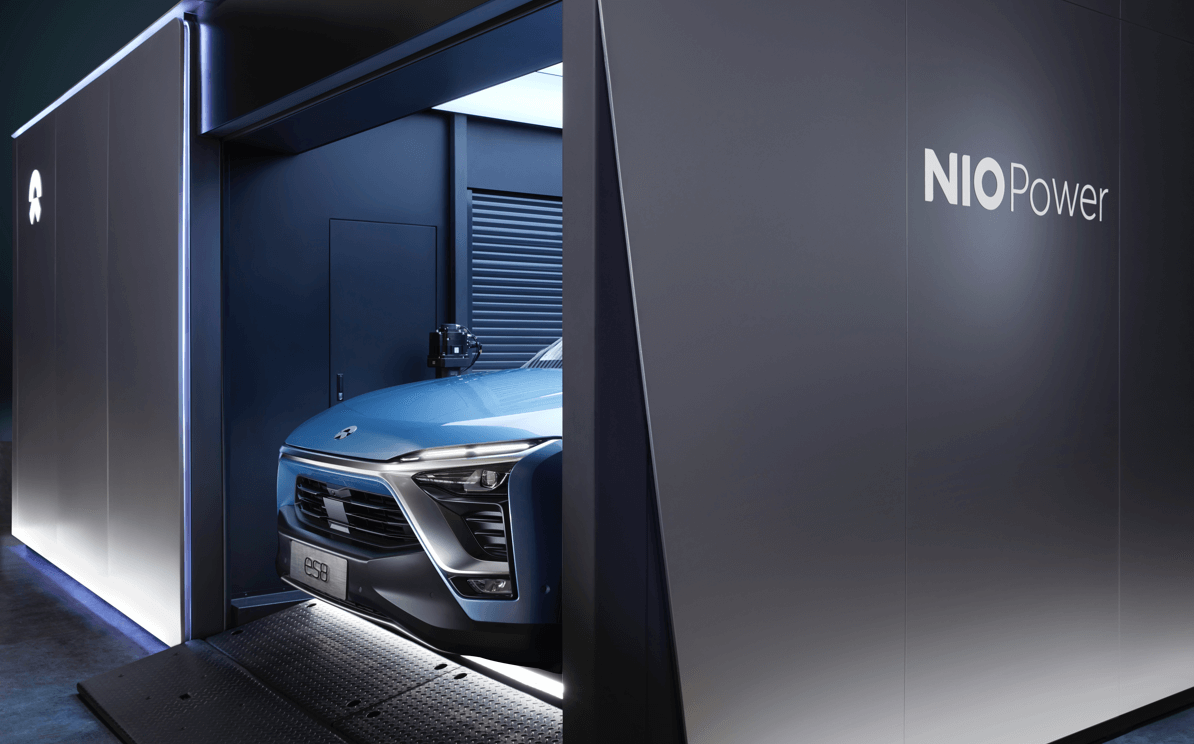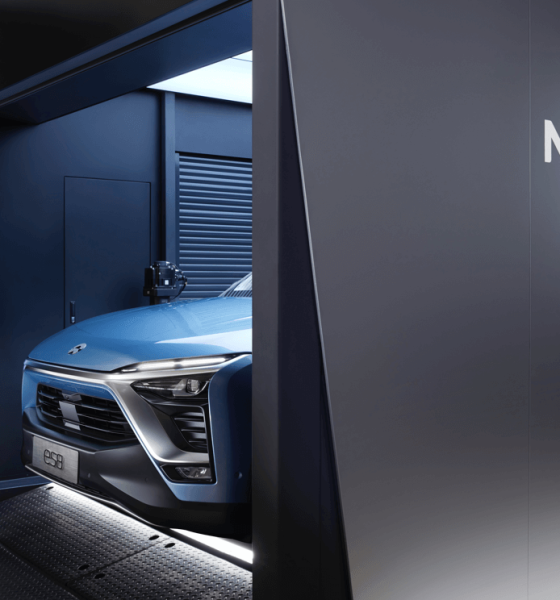

News
NIO’s electric car battery swapping station looks to pick up where Tesla left off
NIO continues to push forward on battery swapping technology that’s aimed at getting its electric cars fueled up in less time than it takes to pump gasoline into a standard internal combustion engine vehicle. NIO owners can use the company’s compact battery swapping stations located in parking lots and other locations for a delay-free power supply for their vehicles. Drivers enter a swap station and wait while an autonomous robot removes a vehicle’s drained battery and replaces it with a completely charged one. With such an option available for quick access to EV power, NIO clearly intends to embrace customer convenience as part of its plan to win over its target customer base.
According to NIO’s IPO last year, this battery exchange service – called “Power Swap” – has been rolled out in nine cities around China, including Beijing and Shanghai. Plans call for 40 to 80 swap stations in place by the end of December. The company announced the completion of its battery swap network along the Chinese G2 Expressway (from Beijing to Shanghai) in early January this year.
NIO is offering a subscription model that’s priced at $200 per month wherein customers can utilize company-provided batteries rather than owning the actual battery that’s attached to their vehicle. If a customer doesn’t own the battery, swapping it out is a mere formality rather than a question of whether their replacement battery is the same quality as the one given up after purchase.


Despite its advantages, NIO’s battery swap plan has given investors pause, and for good reason. This style of recharging concept has gained some closet skeletons in the recent past, particularly via Better Place, the Israeli-based electric car company that gained a pie-in-the-sky reputation trying to become what Tesla ultimately became but went bankrupt instead. Better Place was known for its swap stations, thus wrapping the entire autonomous recharging solution in with Better Place’s downfall, fair or not. The current environment for EVs might change investors’ tune in the near future, though, especially given NIO’s native country’s push for companies just like theirs to exist.
NIO and other electric companies have a unique position with the Chinese government that may help them succeed where others have struggled or failed. Namely, government-driven subsidies and charging infrastructure investments have been offered to China’s customers to encourage the speedy production and expansion of electric car presence. This direct support could be key to NIO’s ability to scale up and profit from its battery swapping business. That, and Tesla’s incredible impact on the demand for electric vehicles and proven ability to implement battery charging networks to ease range anxiety deserves a significant effort.
Tesla has given its own attempt at battery swapping a shot after first demonstrating the capability shortly after Better Place closed up shop. A battery swapping station opened up near the Harris Ranch Supercharger station in Coalinga, CA with appointments available beginning in 2014 as a pilot program. The station appeared to be closed as of 2016, however, and Tesla has only shown an interest in offering the service again via a 2017 patent application for a battery swapping technology after investing its primary resources into developing its Supercharger network. Tesla’s application received a Notice of Allowance for this application from the US Patent and Trademark Office on February 6, 2019, meaning the company has continued to pursue the technology rights and the full patent should issue soon.
NIO opened its doors in 2014 and currently offers two all-electric production vehicles: the ES6 and ES8, both SUVs. Dubbed the “Tesla of China”, the startup successfully delivered 10,000 made-to-order vehicles last year and has made overtaking Tesla in China one of its major goals. Significant investments have been made into branding NIO as a lifestyle company, including exclusive owner clubs and social network opportunities along with customer convenience offerings like the battery swap stations, mobile power vans, and app-based services similar to those offered by Tesla. It remains to be seen whether NIO can successfully revive the battery swap concept, but considering the brave new world of EVs that did not exist a mere few years ago, their hopes certainly don’t seem to be too far fetched.
Watch the below video to see NIO’s battery swapping tech in action:
https://www.youtube.com/watch?v=rmTePwW5HOQ&feature=youtu.be

Elon Musk
Elon Musk’s X will start using a Tesla-like software update strategy
The initiative seems designed to accelerate updates to the social media platform, while maintaining maximum transparency.

Elon Musk’s social media platform X will adopt a Tesla-esque approach to software updates for its algorithm.
The initiative seems designed to accelerate updates to the social media platform, while maintaining maximum transparency.
X’s updates to its updates
As per Musk in a post on X, the social media company will be making a new algorithm to determine what organic and advertising posts are recommended to users. These updates would then be repeated every four weeks.
“We will make the new 𝕏 algorithm, including all code used to determine what organic and advertising posts are recommended to users, open source in 7 days. This will be repeated every 4 weeks, with comprehensive developer notes, to help you understand what changed,” Musk wrote in his post.
The initiative somewhat mirrors Tesla’s over-the-air update model, where vehicle software is regularly refined and pushed to users with detailed release notes. This should allow users to better understand the details of X’s every update and foster a healthy feedback loop for the social media platform.
xAI and X
X, formerly Twitter, has been acquired by Elon Musk’s artificial intelligence startup, xAI last year. Since then, xAI has seen a rapid rise in valuation. Following the company’s the company’s upsized $20 billion Series E funding round, estimates now suggest that xAI is worth tens about $230 to $235 billion. That’s several times larger than Tesla when Elon Musk received his controversial 2018 CEO Performance Award.
As per xAI, the Series E funding round attracted a diverse group of investors, including Valor Equity Partners, Stepstone Group, Fidelity Management & Research Company, Qatar Investment Authority, MGX, and Baron Capital Group, among others. Strategic partners NVIDIA and Cisco Investments also continued support for building the world’s largest GPU clusters.
News
Tesla FSD Supervised wins MotorTrend’s Best Driver Assistance Award
The decision marks a notable reversal for the publication from prior years, with judges citing major real-world improvements that pushed Tesla’s latest FSD software ahead of every competing ADAS system.

Tesla’s Full Self-Driving (Supervised) system has been named the best driver-assistance technology on the market, earning top honors at the 2026 MotorTrend Best Tech Awards.
The decision marks a notable reversal for the publication from prior years, with judges citing major real-world improvements that pushed Tesla’s latest FSD software ahead of every competing ADAS system. And it wasn’t even close.
MotorTrend reverses course
MotorTrend awarded Tesla FSD (Supervised) its 2026 Best Tech Driver Assistance title after extensive testing of the latest v14 software. The publication acknowledged that it had previously criticized earlier versions of FSD for erratic behavior and near-miss incidents, ultimately favoring rivals such as GM’s Super Cruise in earlier evaluations.
According to MotorTrend, the newest iteration of FSD resolved many of those shortcomings. Testers said v14 showed far smoother behavior in complex urban scenarios, including unprotected left turns, traffic circles, emergency vehicles, and dense city streets. While the system still requires constant driver supervision, judges concluded that no other advanced driver-assistance system currently matches its breadth of capability.
Unlike rival systems that rely on combinations of cameras, radar, lidar, and mapped highways, Tesla’s FSD operates using a camera-only approach and is capable of driving on city streets, rural roads, and freeways. MotorTrend stated that pure utility, the ability to handle nearly all road types, ultimately separated FSD from competitors like Ford BlueCruise, GM Super Cruise, and BMW’s Highway Assistant.
High cost and high capability
MotorTrend also addressed FSD’s pricing, which remains significantly higher than rival systems. Tesla currently charges $8,000 for a one-time purchase or $99 per month for a subscription, compared with far lower upfront and subscription costs from other automakers. The publication noted that the premium is justified given FSD’s unmatched scope and continuous software evolution.
Safety remained a central focus of the evaluation. While testers reported collision-free operation over thousands of miles, they noted ongoing concerns around FSD’s configurable driving modes, including options that allow aggressive driving and speeds beyond posted limits. MotorTrend emphasized that, like all Level 2 systems, FSD still depends on a fully attentive human driver at all times.
Despite those caveats, the publication concluded that Tesla’s rapid software progress fundamentally reshaped the competitive landscape. For drivers seeking the most capable hands-on driver-assistance system available today, MotorTrend concluded Tesla FSD (Supervised) now stands alone at the top.
News
Elon Musk’s Grokipedia surges to 5.6M articles, almost 79% of English Wikipedia
The explosive growth marks a major milestone for the AI-powered online encyclopedia, which was launched by Elon Musk’s xAI just months ago.

Elon Musk’s Grokipedia has grown to an impressive 5,615,201 articles as of today, closing in on 79% of the English Wikipedia’s current total of 7,119,376 articles.
The explosive growth marks a major milestone for the AI-powered online encyclopedia, which was launched by Elon Musk’s xAI just months ago. Needless to say, it would only be a matter of time before Grokipedia exceeds English Wikipedia in sheer volume.
Grokipedia’s rapid growth
xAI’s vision for Grokipedia emphasizes neutrality, while Grok’s reasoning capabilities allow for fast drafting and fact-checking. When Elon Musk announced the initiative in late September 2025, he noted that Grokipedia would be an improvement to Wikipedia because it would be designed to avoid bias.
At the time, Musk noted that Grokipedia “is a necessary step towards the xAI goal of understanding the Universe.”
Grokipedia was launched in late October, and while xAI was careful to list it only as Version 0.1 at the time, the online encyclopedia immediately earned praise. Wikipedia co-founder Larry Sanger highlighted the project’s innovative approach, noting how it leverages AI to fill knowledge gaps and enable rapid updates. Netizens also observed how Grokipedia tends to present articles in a more objective manner compared to Wikipedia, which is edited by humans.
Elon Musk’s ambitious plans
With 5,615,201 total articles, Grokipedia has now grown to almost 79% of English Wikipedia’s article base. This is incredibly quick, though Grokipedia remains text-only for now. xAI, for its part, has now updated the online encyclopedia’s iteration to v0.2.
Elon Musk has shared bold ideas for Grokipedia, including sending a record of the entire knowledge base to space as part of xAI’s mission to preserve and expand human understanding. At some point, Musk stated that Grokipedia will be renamed to Encyclopedia Galactica, and it will be sent to the cosmos.
“When Grokipedia is good enough (long way to go), we will change the name to Encyclopedia Galactica. It will be an open source distillation of all knowledge, including audio, images and video. Join xAI to help build the sci-fi version of the Library of Alexandria!” Musk wrote, adding in a later post that “Copies will be etched in stone and sent to the Moon, Mars and beyond. This time, it will not be lost.”








